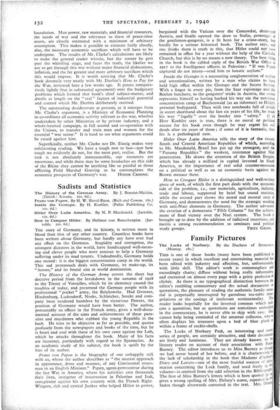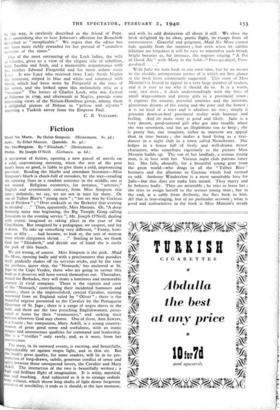Family Pictures
The Locks of Norbury. By the Duchess of Sermonct (Murray. as.) The Locks of Norbury. By the Duchess of Sermonct (Murray. as.) THis is one of those books (many have been published in recent years) in which excellent and entertaining material has been edited with industry and affection, but, unfortunately, with little skill. The editor's work is commonplace and exceedingly chatty; diffuse without being really informative, and encrusted on almost every page with a gritty profusion of clichés. As there is no typographical distinction between the editor's rambling commentary and the actual documents ee quotations, the pleasure of reading the authentic family mate- rial is perpetually interrupted by garrulous tea-table inter. polations or the cooings of irrelevant sentimentality. The reader looks hopefully for the inverted commas which indk cute a quotation; but as quotations are sometimes embedded in the commentary, he is never able to skip with ease. One cannot help being reminded of the amateur collector, who so often displays his treasures upon a bed of blue plush af within a frame of cockle-shells.
The Locks of Norbury Park, an interesting and exotic series of people, are certainly attractive, and their document' are lively and luminous. They are already known to the literary reader on account of their association with Fang Burney. The editor introduces us to Miss Burney as thong) we had never heard of her before, and it is characteristic el the lack of scholarship in the book that Madame d'Arblay'l Diary and Letters—one of the most fruitful sources of info! mation concerning the Lock family, and used freely in thll volume—is omitted from the odd selection in the BibliograPh! The first of Miss Burney's letters which is here quoted (i. gives a wrong spelling of Mrs. Delany's name, repeated in Index though afterwards corrected in the text. Mrs. De by the way, is carelessly described as the friend of Pope. It is astonishing also to hear Johnson's affection for Beauclerk described as "inexplicable." We regret that the editor has not been more richly rewarded for her persual of "countless memoirs of the times."
One of the most entrancing of the Lock ladies, the wife of Charles, gives us a view of the elegant side of rebellion, both Jacobin and Irish, and a memorable acquaintance with her brother Edward Fitzgerald and his more ardent sister Lucy. It was Lucy who received from Lady Sarah Napier the waistcoat, striped in blue and white and saturated with blood, which had been worn by Fitzgerald at the time of his arrest, and she looked upon this melancholy relic as a "treasure." The letters of Charles Lock, who was Consul at Palermo in 1799, and afterwards at Naples, provide some interesting views of the Nelson-Hamilton group, among them a delightful picture of Nelson in "pelisse and aigrette" receiving a Turkish envoy from the Emperor Paul.
C. E. VULLIAMY.







































 Previous page
Previous page